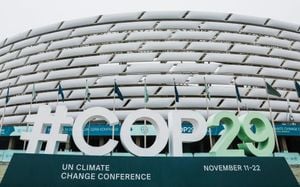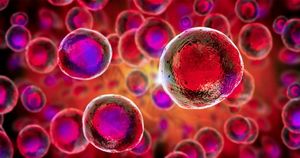Mystery and speculation are swirling around Russian President Vladimir Putin's latest video address, where he threatened both Ukraine and the West with what he claims are his unstoppable 'Oreshnik' missiles. Delivered with unnerving stillness, Putin's demeanor has ignited debates about the authenticity of the footage, leading many to ponder whether it was manipulated through advanced technology.
During the nearly eight-minute-long televised speech, Putin sat behind his desk, his hands seemingly frozen, which observers noted as particularly odd for a leader known for his animated presentations. The absence of movement raised eyebrows, prompting doubts about the validity of the video – with social media users speculating it might be the work of AI-generated deepfake technologies.
Notably, Ukrainian internal affairs adviser Anton Gerashchenko was quick to voice his suspicions on social media, highlighting how the footage appeared unusual when sped up. “If you speed up the video, it is visible,” he remarked, “that Putin’s hands are not moving and look like they are separate from his body.” This observation, combined with others, has fueled rumors about the leader's health and the legitimacy of the broadcast.
Experts weighed in on these deepfake claims, providing insights on how these digital manipulations operate. Deepfakes utilize artificial intelligence to mimic voices and facial expressions, creating video content so lifelike it can mislead viewers. For this technique to be effective, substantial data is required from the subject, including various angles and expressions, to train the AI.
Documentary filmmaker Christopher Shoebridge also offered his perspective, stating the Kremlin's production looked “totally faked.” He went so far as to claim someone else’s hands may have been inserted using digital techniques, and the robotic nature of Putin’s head movements appeared unnatural. The timing of this address is noteworthy as well; the Kremlin reports suggest Putin has been largely absent from public view for about two weeks leading up to his speech.
For analysts, deciphering the authenticity of the video remains complex. Shweta Singh, assistant professor at Warwick Business School, expressed the difficulty of forming concrete conclusions about whether the address was real or manipulated without clear evidence. She noted, “Despite the fact Putin gesticulates a lot in his other speeches, here his hands don’t move.”
The controversy surrounding Putin's address arises at a precarious moment for the Russian leader, coinciding with Ukraine’s newly acquired capabilities to launch U.S. and British long-range missiles capable of reaching deep within Russian territory. This geopolitical backdrop creates tension as Putin attempts to project strength amid mounting pressures.
Putin's threats take on added weight against the backdrop of his claim of deploying the hypersonic 'Oreshnik' missile against Ukraine, particularly following geopolitical escalations like U.S. President Joe Biden’s approval for Ukraine to use American-supplied long-range munitions. Putin articulated his declaration as part of Moscow's strategic responses to the greater conflict, stating, “Our new generation intermediate-range missiles are ready to be used,” framing them as counteractions to NATO’s support for Ukraine.
This declaration has prompted significant alarm, both in the West and among security analysts, who recognize the potential repercussions of such missile deployments. Dr. Paul van Hooft, a defense analyst, offered insights on the situation, describing Putin's position as increasingly precarious. According to him, the leader has “boxed himself in” with his repeated nuclear threats, which not only risks provoking international retaliations but also potentially destabilizing his domestic support due to the growing dissent among Russian elites.
The deployment of hypersonic capabilities by Russia has prompted fresh fears about global security and arms control. Hypersonic missiles, characterized by their speed and ability to maneuver, pose severe challenges to existing defense systems, leading to doubts about their efficacy and the risks of miscalculations during conflicts. Western analysts have expressed concerns these developments might fuel greater militarization and complicate diplomatic resolutions.
All the same, some experts believe there are checks on Putin's power. Nicholas Drummond, another security analyst, remarked on the possibility of dissent from within the Russian oligarchic class if Putin's actions are perceived as too reckless. He noted, “If he is seen to be doing something reckless, the kingmakers among the oligarchs could rise against him. There could be civil war.”
What’s more, with growing discontent over the costs of the war – both financially and socially for Russia – Putin’s aggressive rhetoric might be more of a tactic to maintain control rather than genuine intentions to escalate the confrontation. He’s been portraying strength as he contends with the realities of military losses and growing discontent among Russian citizens.
The potential for catastrophic conflict looms large as analysts warn tensions could spiral out of control. Multiple experts have characterized the current state of affairs as nearing the brink of World War III if diplomatic avenues do not prevail. Social media is rife with speculation about Putin's mental and physical health, with some users joking about his immobility during the speech, hinting at possible medical issues.
Despite the uncertainties, Putin’s insistence on showcasing Russia's military capabilities seems to be aimed at obviously deterring any thoughts of NATO or Western intervention. The recent display of hypersonic missile tests reflects his approach to project national strength, yet the broader picture shows how fragile this strategy can be as power dynamics shift.
Putin's threats of escalation come with serious undertones, and even as he conveys strength, the fear of instability within Russia’s political elite only adds complexity to his position. His reliance on aggressive tactics appears to clash with the potential for internal unrest and external backlash, matching the tension of his latest public appearance with the uncertainty surrounding his leadership.



